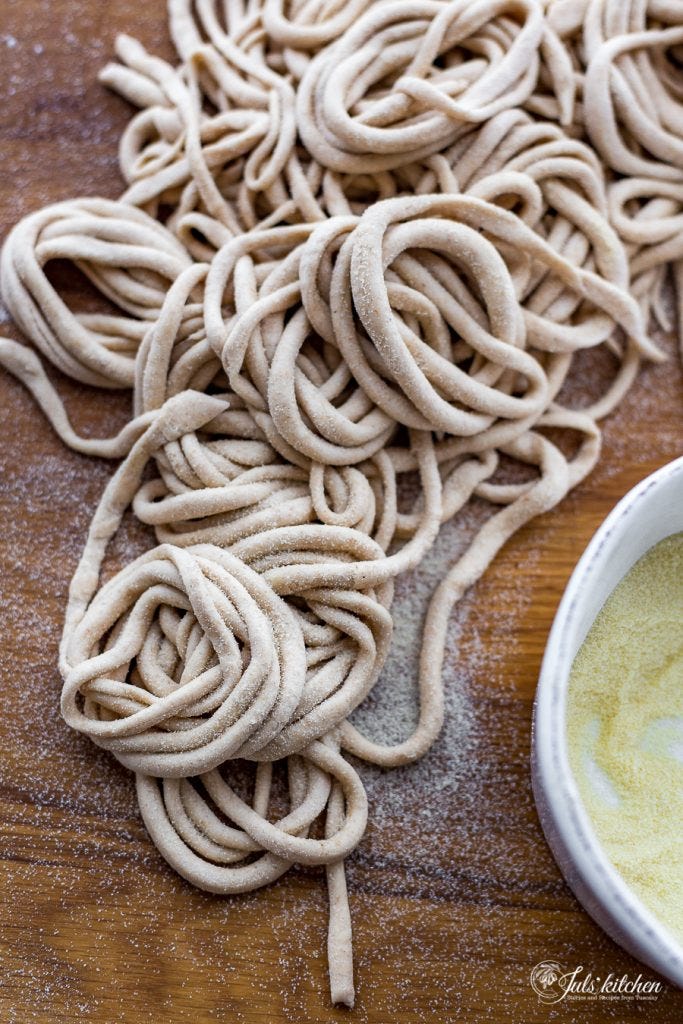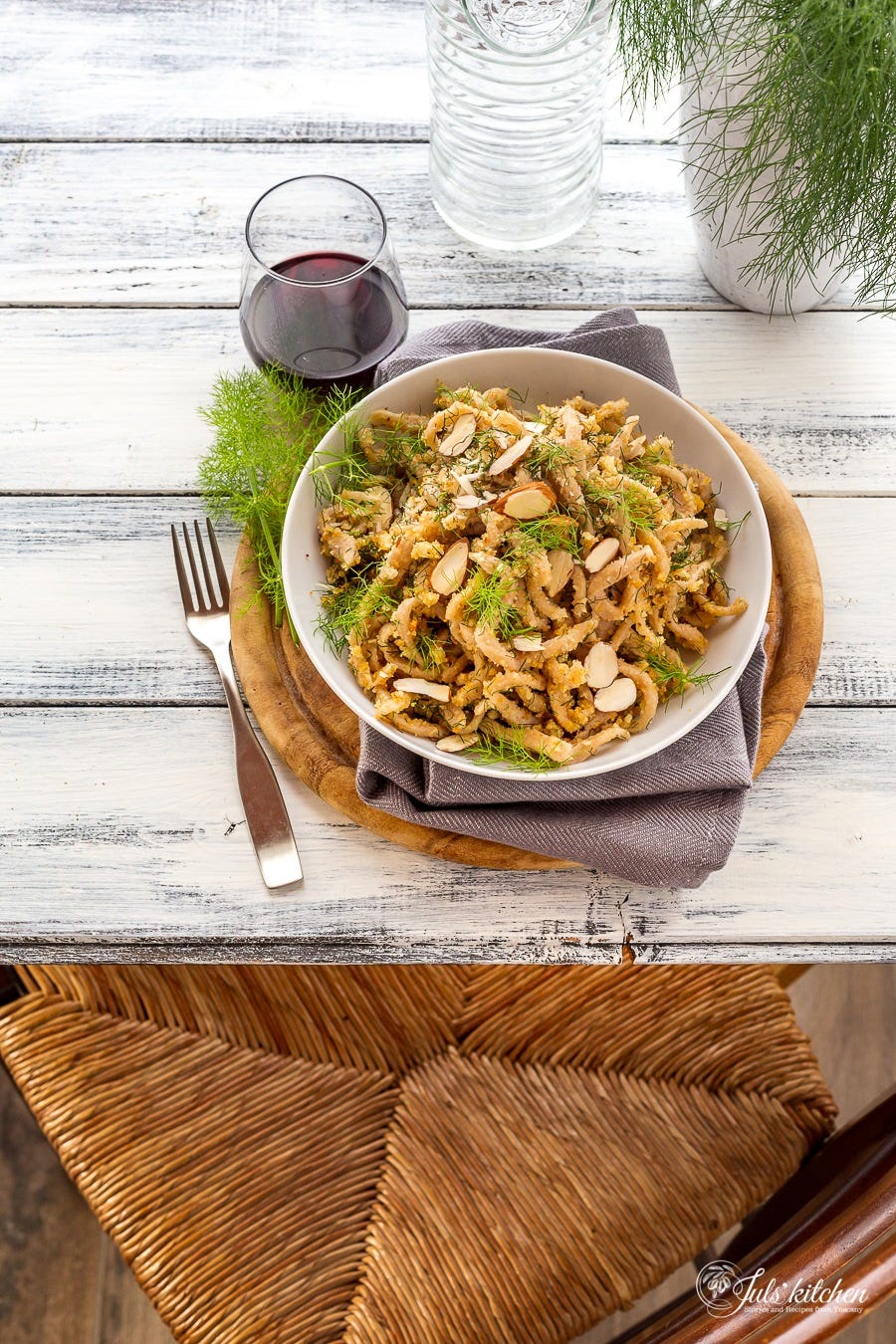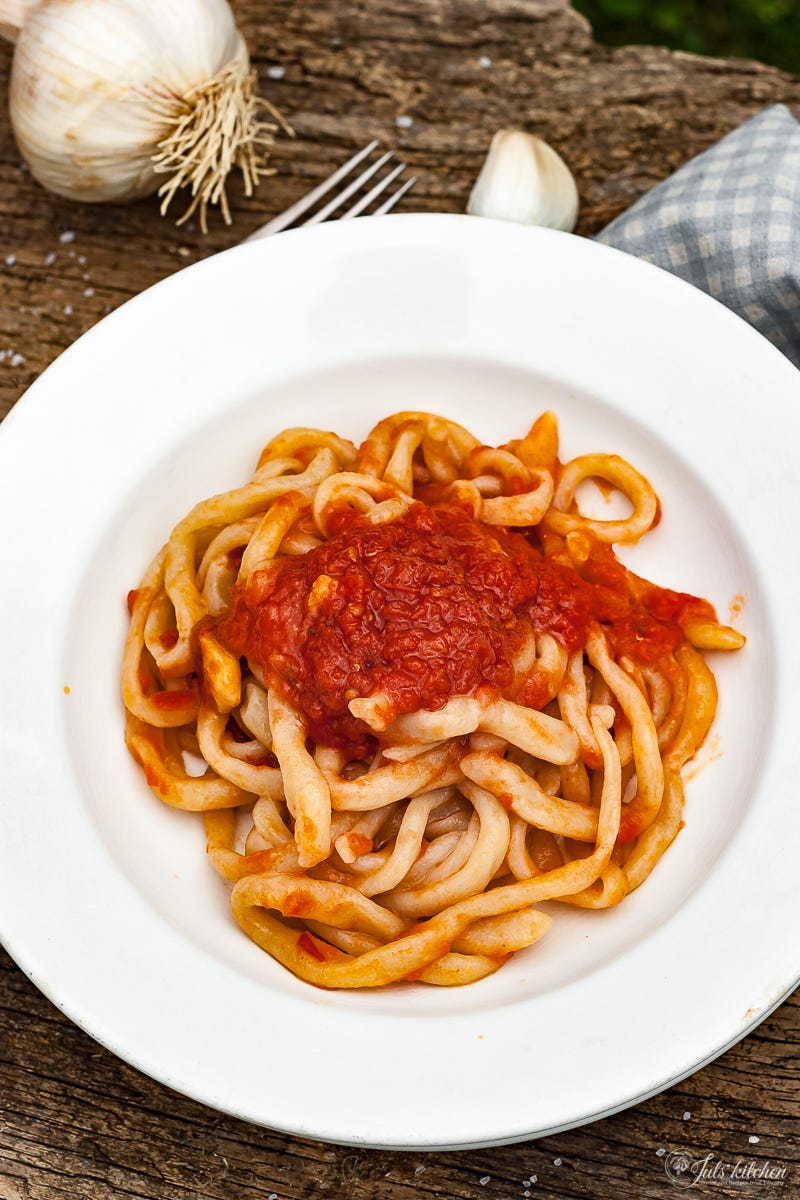[Pantry] Pici, tuscan fresh pasta
The Tuscan hand pulled fresh pasta you can make with flour and water
I will never forget the first time I met Luisa, my friend from Agriturismo il Rigo. I ate humble pie.
I had organized an intensive day at home where we would cook together and learn about food writing and food photography. Ten women from all over Italy joined me for the day: among those women, there were Luisa and her sister Martina.
I had studied the menu to be simple, wholesome, and inclusive, as there was a vegan participant, too.
That’s why I chose to make pici, thick, hand-pulled spaghetti from Valdorcia, made just with flour and water. Then, I would toss them in a punchy aglione sauce, made with a local variety of garlic, huge, sweet, and delicate.
When it was time to demonstrate the recipes, I gathered all the participants around the table and started kneading and stretching the pici dough. Luisa was silent and quiet. Everyone took their turn to pull pici, but when Luisa put her hands in the dough, magic happened. She started pulling and rolling pici like a pro, quick and efficient. Eventually, she revealed that she would usually make pici for 40 people on a regular basis in her Agriturismo. I could just stare at her in awe and learn as much as I could from her effortless, exact gestures. After that, we became good friends.
Since then, I’ve been making pici countless times, and even though I’m not as quick and impressive as Luisa, I’m now an experienced pici maker, and so is Tommaso.
But back to pici, the perfect pantry pasta.
To make them, all you need is all-purpose flour and water, then a generous pinch of salt and a (Tuscan) drop of olive oil, which is more a drizzle to international standards.
Their straightforwardness also replicates in the tools needed: a wooden board - or your table -, a rolling pin, and a pizza cutter or a sharp knife. No pasta machine is required. You do everything by hand, it is just like making worms with play-doh, and that’s why children love pici.
During our cooking classes, they were always a hit, the easiest pasta you can replicate at home with ingredients that probably are already sitting in your pantry.
Pici as your next weekend cooking project
There are several recipes to make pici on the blog, and today I’m sharing here some of my favourites. Maybe homemade pici could become your next weekend cooking project?
Pici are usually served all’aglione, with a rich tomato sauce and an outrageous quantity of garlic, cacio e pepe, a creamy sauce made just with grated pecorino cheese, a ladleful of starchy cooking water and black pepper, and con le briciole, literally with fried breadcrumbs.
Pici con le briciole - Pici with breadcrumbs
If pici are the perfect pantry fresh pasta, this crunchy dressing is just as perfect.
I usually collect all my stale bread and prepare a large batch of breadcrumbs once in a while. Making it at home allows you to choose the coarseness of your crumbs: use fine breadcrumbs for coating meat and fish and for dusting over a potato gratin, and coarse breadcrumbs for stuffings or for recipes like this.
A grating of lemon zest, an anchovy fillet melted in olive oil, or a tablespoon of tiny capers are a great addition to this dish, and move it from Tuscany to sunny Sicily.
Get the recipe here.
Pici all’aglione
Even though to make the original aglione sauce you would need the local aglione, try this recipe with the garlic at your disposal for a punchy, thick and glossy garlicky tomato sauce.
Aglione is a giant garlic - a clove is about 70 - 80 grams, and a head of aglione can reach 500 grams! - that is sweeter, more delicate, and easier to digest than regular garlic. It is highly local - grown in Val di Chiana, in the provinces of Siena, Arezzo, and Perugia, and therefore tough to find outside this area.
Get the recipe here.
Pici with butternut squash and Pecorino Toscano
The best flour to make pici is all-purpose flour because it has less fibres than stone-ground or whole wheat flour. As to make pici, you are pulling the dough, fibers can prevent you from having an elastic, easy to stretch the dough.
To give more flavour to the pici dough, sometimes I like to add a small amount of rye flour, as in this recipe.
The dressing is seasonal, my pièce de résistance during autumn cooking classes: butternut squash and leeks cook on low flame doused with extra virgin olive oil until they become a sauce, crumbled fresh sausages add a savoury and peppery note, and a generous handful of fresh Pecorino Toscano melts in the pan and embraces the pasta.
If you decide to participate in the weekend cooking project, share the results with us on social media by using the hashtag #myseasonaltable and tagging @julskitchen on Instagram.
If you have questions about the ingredients or the recipe, if you have a special request for one of the following cooking projects, or want to have a chat, reply to this email.
Support us by joining our paid newsletter
When we first launched our subscription-based newsletter back in March, we thought it was mainly about sharing recipes. We could not believe it could become for you an anchor to Italy, to the Italian table and our loud conviviality, a reason to experiment with lesser-known ingredients, the voice of a friend in the kitchen.
At the monthly cost ($5) of a gelato with double whipped cream, or at the annual cost ($40) of a good bottle of extra virgin olive oil, you can support our own independent publication directly.
It is demanding to keep this newsletter active, interesting, and useful for you, on a twice a week basis and in two languages. For us it is like curating our own food magazine: we share seasonal recipes, essays, menu ideas, stories, ingredient insights, links, and travel tips. When you join Letters from Tuscany, you know you will receive twice a week some valuable content in your inbox, just like when your favourite food magazine is dropped at your doorstep.
What you missed recently: Pasta alla puttanesca, Ciaccino with ham and mozzarella, Leek and potato soup, Pittule salentine, Sienese Christmas panforte.
Whenever you decide to join us, you will have complete access to the whole archive of already published recipes and stories.









Thanks for this, Juls! I’ll make the fresh pici as well. This post is a gold mine of delicious, simple recipes!